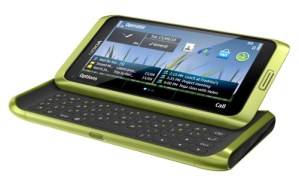
Finland’s Nokia has revealed that it will be delaying the introduction of its latest flagship handset, the Nokia E7, until early 2011. The handset is similar to the well-regarded Nokia N8, but features a slide-out QWERTY keypad along with Symbian^3, the latest version of the Symbian mobile operating system. The delay also makes the E7 like the N8 in another way: Nokia also delayed the launch of the N8, and then was forced to admit some shipping N8 devices had power problems.
The delay casts more doubt over Nokia’s future in the high-end phone market. Although the company remains the world’s largest mobile handset manufacturer, a large portion of those sales are entry-level devices in developing markets. The company was caught flat-footed by the sudden popularity of smartphones inaugurated by the Apple iPhone, and still hasn’t come up with a solid response to either the iPhone or smartphones running Google’s Android operating system. Nokia has also seen a series of leadership shake-ups, bringing in former Microsoft executive Stephen Elop as CEO, and announcing the company was bringing Symbian development back into Nokia from the open source Symbian Foundation.
However, according to Nokia’s presentation at the Mobile Internet Conference in Beijing this week, 2011 could be a huge year for the company. According to the presentation, Nokia plans to bring 1 GHz processors to its phones in the second or third quarter of 2011. Further down the line—late 2011 or early 2012—Nokia plans handsets with dual-core processors and an unspecified “true zoom camera”—speculation has centered on Nokia developing a cameraphone with a true optical zoom, rather than a digital zoom.
In the meantime, Nokia plans to get aggressive with updating its Symbian operating system, indicating it plans launch four or five updates to its Symbian OS in the next 12 to 15 months—that’s an average of a new release ever three months. The rapid releases will enable Nokia to introduce incremental updates and new features rather than rely on large, monolithic updates to the mobile operating system. Nokia plans to revise the Symbian user interface, add an updatable HTML5 Web browser.
Industry watchers are hopeful these announcements indicate a new momentum getting underway at Nokia, but some wonder if it may be too late: the iPhone has been on the market since 2007, and sales of Android devices have skyrocketed in the last year.
Editors' Recommendations
- Motorola One Zoom vs. Nokia 7.2 vs. Google Pixel 3a: Midrange melee
- OnePlus 7 Pro vs. Galaxy S10e vs. iPhone XR: A selection of flagship killers

